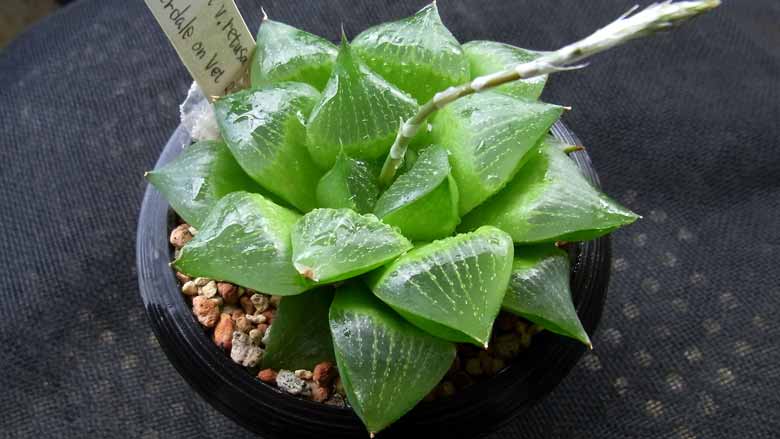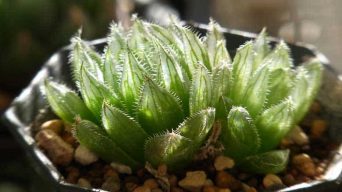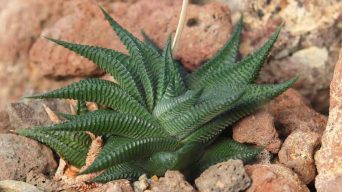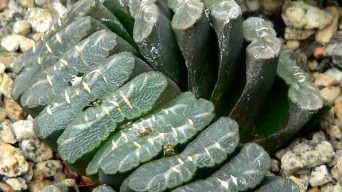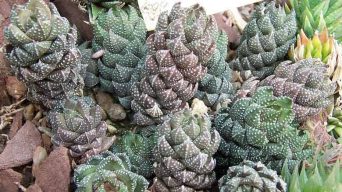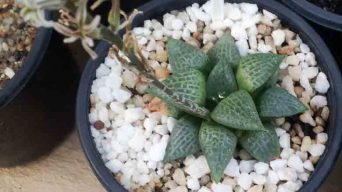The Haworthia retusa, commonly known as Star Cactus, is a succulent plant with an interesting appearance.
It tends to be low-maintenance, making it a perfect addition to many gardens.
However, this does not mean they are without challenges – Haworthias are sensitive plants requiring consistent care to thrive.
This article will provide you with all the information you need on Haworthia retusa care, including how to propagate them.
Overview
The Haworthia retusa (Star Cactus) is native to Western Cape Province in South Africa.
It is a flowering plant belonging to the Haworthia genus and family Asphodelaceae.
The Haworthia retusa is a slow-growing succulent that forms star-shaped rosettes that are typically 6 inches in diameter with lime green leaves. The leaves have translucent triangle tips marked lengthwise with thin lines.
A tall flower stalk with small, tube-shaped white flowers emerges from the center of its star-shaped rosette. It usually appears in late spring to summer and can grow up to 20 inches.
The Haworthia retusa is native to Western Cape Province in South Africa.
Some of the names by which it is commonly known are:
- Star cactus
- Window succulent
- Aloe retusa
- Apicra retusa
- Catevala retusa,
- Haworthia retusa var. retusa
How To Care for Haworthia Retusa (Star Cactus)
Haworthia retusa care is relatively easy because they are considered a low-maintenance succulent.
However, haworthia retusa is also a succulent plant that requires some maintenance to thrive and remain healthy.
If you own this Haworthia species and would like to know more about how to keep it growing properly, read on!
Sun Exposure & Light Requirements
Haworthia retusa plants can grow in full sun or partial shade. They will do best with a lot of direct sunlight outdoors but partial shade indoors.
They prefer being in the sun for part of the day and then some hours in lower light. So if you have Haworthias inside, consider placing them near windows facing south or west where there’s more natural light available.
Indoors they’ll be happiest when they’re next to a window that receives lots of indirect sunlight.
Outside avoid planting Haworthias in full sun in the middle of a hot day; instead, give them plenty of exposure on cooler days and make sure they get watered often.
In the winter, make sure they get even, bright light.
Haworthias will do best with as much natural sunlight as possible. They would prefer not to be in an environment that’s too dark or dimly lit all day long.
If Haworthia retusa plants are given enough indirect light indoors, they won’t require additional artificial lighting at night.
Watering Requirements
Haworthias are native to semi-arid regions, so they require very little watering.
They thrive in the wild on what would be considered dry riverbeds with only a few inches of rainfall per year and cannot handle being overwatered, or their roots will rot.
Haworthia retusa plants need to be watered at least once every two weeks during hot weather and four times a month when it’s cold outside.
The soil should never completely dry before you plan to water them again.
The best approach is to pour about an inch of water around the haworthia retusa plants every week or two and let gravity do the work for you.
Frequent watering will cause rot, but don’t go overboard either by leaving your succulents in standing water.
Soil Requirements
Haworthia retusa plants do need proper soil to stay healthy. The best potting soil for them is a cactus and succulent soil mix.
This mix should be light and porous to allow for good drainage and air circulation around roots.
A well-draining soil will reduce the chance of overwatering, which can cause rot in haworthia retusa plants.
A cactus and succulent mix will also help Haworthia retusa stay healthy by providing nutrients to support plant growth and prevent root damage from higher salt levels found in standard potting mixes.
Adding some organic matter or sand to the potting soil is also a great idea. This mixture allows air while still holding water so that roots do not sit wet on soggy ground.
Temperature and Humidity
The perfect temperature range for Haworthia retusa plants to thrive ranges between 60-90 degrees Fahrenheit, while they will still survive at temperatures as low as 45-50 degrees if given enough light and water.
This succulent thrives in an average indoor environment that is also warm.
Haworthia retusa do not require significant humidity levels because they are native to arid regions that receive very little rainfall.
They are very sensitive to high levels of humidity that can cause them to rot or develop fungus.
They thrive in environments with a relative humidity between 50-70%, which can be achieved by placing a tray of pebbles underneath the pot and watering less frequently.
Fertilizing
Haworthia retusa succulents don’t require much fertilizer.
If you do fertilize, use a diluted balanced fertilizer once every two months.
You’ll want to fertilize haworthia retusa succulents as needed. Every two months is usually sufficient, but if growth has slowed or stopped, you may want to fertilize more often (every month).
If haworthia retusa succulents are growing in soil, use a balanced fertilizer that contains three major plant nutrients: nitrogen, phosphorus, and potassium.
Dilute the fertilizer by adding water before applying it to your plants.
If haworthia retusa succulents grow in pots with a cactus mix, you can fertilize them once every other month.
Potting and Repotting
Haworthia retusa are slow-growing plants and can stay in one pot for years.
However, Haworthias should be transplanted into fresh soil every two to three years because the potting soil becomes depleted of nutrients.
To repot a Haworthia plant, pull apart the succulent and gently shake off any excess soil from the roots.
After you’ve shaken off all the dirt, trim away any dead or damaged roots with a pair of pruning shears.
Add a new layer of potting soil to the Haworthia, and then carefully place it back into the container.
Cover any exposed roots with additional soil so that only a few millimeters are visible above ground level.
Water your Haworthias well after repotting them to settle the dirt around their roots. It’s important for Haworthias not to be planted too deeply, or they risk being damaged by watering from overhead sprinklers.
Pruning
Haworthia retusa are very slow growers, so it is normal to see some browning on the leaves.
In most cases, Haworthias will only need trimming once every two years or when they start to look overgrown and straggly.
The Haworthia can be trimmed by simply cutting off any dead stems or leaves at their base with scissors.
If you want your Haworthia to grow more compact rather than spreading outwards, trim away the outer edges of the plant near its pot.
This way, new growth should come closer to the center, where they’ll have less space to spread outwards again as they mature.
Pests and Diseases
Haworthia retusa plants are not prone to many pests or diseases.
The most common type of pest is mealy bugs. They are small and white but can be found on the underside of leaves or in leaf sheaths.
To combat mealybug infestations, you need to use a cotton swab dipped in rubbing alcohol and then wipe the bugs off.
You can also wash them away with water from your garden hose.
In addition to pests, Haworthias can develop fungal infections such as powdery mildew.
For this type of fungus, all you need to do is remove the infected leaves and wash off your Haworthia with a forceful stream of water.
Haworthias can be susceptible to other types of pests: spider mites, scale insects, mealy bugs, or whiteflies.
Some people will opt for pesticides in these situations, which may not always be suitable for Haworthia plants.
How to Care for Haworthia Retusa (Star Cactus) in Winter
Haworthia retusa winter care is easy once you know a few basics:
- Protect your haworthias from freezing temperatures, harsh winds, intense sunlight, and frost. Bring them indoors or at least into a sheltered area outdoors away from cold, windy conditions until warmer weather returns.
- Reduce watering haworthias in winter. It is important to water haworthia retusa plants during the colder months, but not as often or deeply as they need when temperatures are warmer outside.
- If your plants are placed in a shady area outside during colder weather, it’s best to move them into full sun as soon as temperatures warm up again until nighttime temps begin dropping below 50 degrees Fahrenheit (or around 15 Celsius)
- Do not fertilize haworthias during the winter.
- If you live in a milder climate, haworthias can be overwintered outdoors but should still receive protection from cold temperatures and harsh winds.
- In warmer climates, haworthia retusa plants may need to be brought inside for the winter.
How To Propagate Haworthia Retusa (Star Cactus)
Haworthia retusa, also known as Star Cactus, is a succulent plant that propagates well from offsets and leaf cuttings.
Offsets
Offsets are the best way to propagate Haworthia retusa because they form on their own and usually grow quickly.
The offsets will form at the Haworthia retusa mother plant base, usually during springtime when it starts to get warm or in fall before the frost comes.
You can separate these Star Cactus offshoots with your hands. Let the offsets dry for a few days and replant them into any potting mix.
It is important not to overwater these offsets as this will lead to mold or rot, but if you water them often enough (not too much), they should root in a couple of weeks.
Leaf Cutting
Haworthias can also be propagated from leaf cuttings, an alternative propagation method for many other succulents, including Haworthia retusa.
It would be best to look for a healthy leaf that is not too big to avoid breaking the stem.
Cut the leaf from the Haworthia plant and allow the leaf to callous for several days.
Once it has calloused, then you can proceed to plant the leaf-cutting.
It is important not to overwater these leaves as this will lead to mold or rot and instead, water them often enough (not too much).
If done correctly, they should start rooting in a couple of weeks.
Is the Haworthia Retusa (Star Cactus) Toxic?
Haworthia retusa (Star cactus) is not toxic to humans and animals. Still, it does have a sap that might irritate the skin.
The sap can cause mild dermatitis if you are sensitive to plants and don’t wash your hands after handling this plant.
Some people may be allergic to haworthia retusa (Star cactus) sap and react with a rash.
If you know you’re sensitive, wear gloves or keep your hands away from contact when handling the plant.
Final Thoughts
Haworthia retusa is a low-maintenance succulent that makes an excellent addition to any collection.
This unique and beautiful succulent is perfect for the beginner succulent enthusiast or collector.
With its small size and ease of propagation, it is also an excellent plant for those looking to start their own specimens to trade with others or give as gifts.

